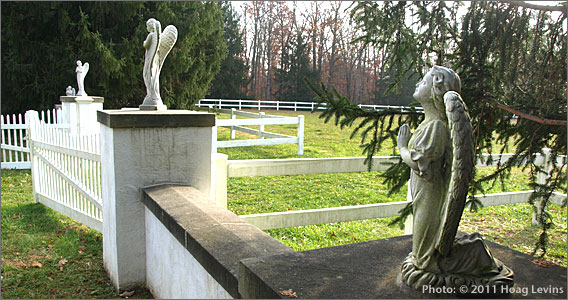ANCORA, N.J. -- Recently, while Googling online sites related to Camden County history, I came across this description of Ancora and its Veterans Haven on StrangeUSA.com:
"(Veterans Haven) was once a town the psychiatric hospital made for patients to all live together. Many of the patients murdered each other; most of them are old vets from the war. Eventually, so many killings took place they just shut the whole town down. It has a lot of paranormal activity and the streetlights are still left on throughout the little deserted ghost town."
Lurid tales
Similarly lurid tales of deranged war vets and ghosts run wild through an abandoned-village-turned-Pinelands-killing-zone popped up on more than a dozen other websites.
I have to admit that at first I wasn't really sure how much of this was true or not, because, after all, Ancora Psychiatric Hospital has always been one of those places locals tend to know of but not much about.
Growing up in South Jersey and driving Route 30 for years, I had seen the sign pointing to the hospital

Photo: Hoag Levins
|
| Although they run all along Spring Garden Rd., the outer fences of Ancora Hospital are hidden in the treeline. Larger |
and read news stories of escaped inmates and state investigations. But I had never made that right turn off the White Horse Pike. Once I did, I was surprised to find out how much history there is along this little-known area of lower Camden County. A two-lane highway running from Route 30 to South Egg Harbor Road, it only takes six minutes to drive from one end to the other of Spring Garden Road. But its three miles traverse a century of history rich with stories about the evolution of modern medicine, a TB hospital, a prison farm, homeless vets, a psychiatric hospital, a disappeared village and, oh yes, escaped killers.
TB Sanitarium
One of the first things you see when you turn off Route 30 is what's left of an elaborate old stone-and-wrought-iron entrance gate that opens into tangles of wild growth beyond.

Photo: Hoag Levins
|
| An ornate roadside gate is all that's left of Sunny Rest, the county's first tuberculosis sanatorium. Larger |
This was the site of Camden County's first sanatorium for tuberculosis patients. Called Sunny Rest, it opened in 1914 with 75 beds, large banks of windows and a separate nurses' residence, all of which have since been torn down.
At the turn of the twentieth century, tuberculosis, a.k.a. consumption and "the white plague," was a leading cause of death in America. Before the age of antibiotics, the only way to control its spread was to isolate infected patients in hospitals specifically dedicated to fighting TB. One major form of treatment was "phototherapy" -- exposing patients to direct sunlight and plenty of fresh air for extended periods of time. The area just beyond this arched gateway was once a spacious lawn where patients lolled on the grass or relaxed in the shade of the huge trees that still remains.
But just eleven years after it opened, Sunny Rest was closed. Too small to accommodate the rapidly growing numbers of
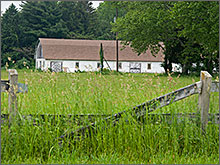
Photo: Hoag Levins
|
| A county prison farm was once located along this stretch of Spring Garden Road. A barn is one of the few structures still standing. Larger |
county TB patients, it was replaced by a larger, more modern sanatorium built 20 miles northwest at Lakeland in Blackwood. Prison Farm
The county also built something known as the Ancora Prison Farm a short distance from the one-time site of Sunny Rest. It was described in 1939 as a well-kept farm providing vegetables, poultry, dairy and fruit from orchards and vineyards that lined the highway. Every autumn, at a local viniculture exchange, grapes were sold to wine manufacturers and local Italian residents who made homemade wine.
An average of 30 inmates lived on the prison farm in 1955, clearing, grading and seeding the grounds as well as providing the physical labor needed to clean buildings and move furniture as the new Ancora Psychiatric Hospital prepared to open in April of that same year.
Sunny Rest and most of the prison farm are now gone, but if you wander back through the grounds,
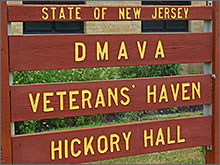
Photo: Hoag Levins
|
| Veterans' Haven, operated by the New Jersey Department of Military and Veterans Affairs, sits on state land just outside the fenced perimeter of Ancora Hospital. Larger |
you'll still find a barn, tool shed, an old greenhouse and a tiny well house still standing as reminders of the past. Veterans' Haven
A simple green-and-white sign marks the junction of Lake Drive and Spring Garden Road and the entrance to Veterans' Haven. But if you make that turn hoping to find traces of a ghost town crackling with paranormal activity, you'll be disappointed. The real Veterans' Haven is just that: A transitional housing facility and structured care program designed to safely reintegrate some of New Jersey's estimated 8,000 homeless veterans back into the community.
It rises from well-landscaped grounds as a modern, yellow-brick building with a cheerful, terra-cotta-colored entry pavilion lined by American flags. As of 2010, over 800
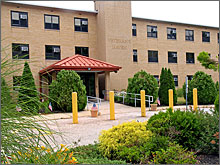
Photo: Hoag Levins
|
| Veterans Haven is a modern facility that houses homeless New Jersey veterans. Larger |
veterans had passed through the facility. Of those who successfully completed the program, close to 70% were sober, reunited with family members, and either employed or in school six months later. Behind the Veteran's Haven complex, as far as the eye can see, snake high metal fences enclosing the adjacent grounds of Ancora Psychiatric Hospital. Opened in 1955, its sprawl of buildings -- all linked by an underground tunnel system -- was originally designed to house 2,500 patients. Those patients were attended, guarded, counseled or treated by a staff of 400, almost all of who lived with their families on hospital grounds in rent-subsidized bungalows and dormitory-style apartments. Covering more than 650 acres, Ancora was a self-contained community with its own laundry, sanitation department, power plant, police and fire departments -- even a small fenced-in pasture for 20 dairy cows that were part of the prison farm.
Today, the complex houses 451 patients, the majority of whom suffer

Photo: Hoag Levins
|
| Ancora Psychiatric Hospital was opened in 1955 and sprawls across more than 600 acres at the edge of the Pinelands. Larger |
various forms of schizophrenia, bipolar disorder and major depression. Many of them are also being treated for drug or alcohol abuse; almost all of them are on some type of psychotropic medication. To be sure, the hospital has had its share of sensational news coverage. In 2008, the Asbury Park Press published "Troubles at Ancora Psychiatric Hospital" -- a series of articles that described, "Overcrowding; poorly-trained staff; rampant drug abuse; and a constant danger of being assaulted or even murdered -- not only for patients, but for staff as well."
Despite the peacefully bucolic Pinelands environment one finds along Spring Garden Road, Ancora is, after all, home to some pretty scary people.
Criminally insaneIt houses more than five dozen criminally-insane inmates -- individuals

Photo: Hoag Levins
|
| Ancora is a place of high security and many types of fences. Its population of criminally insane inmates are housed in a separate prison-like compound. Larger |
tried and found not guilty by reason of insanity -- in addition to 25 patients charged with a crime and sent to the hospital for evaluation and/or treatment. There are also some 20 sex offenders who have been sent to Ancora as Megan's Law offenders. Today, this criminal population is housed in an isolated Secure Care Unit encircled by two high-security prison fences and closely monitored by guards and sophisticated electronics systems.
But in 2007 the escapes of two patients made headlines. The first was William Enman, a paranoid schizophrenic who beat a man and his 4-year-old son to death with a baseball bat. He escaped from a building surrounded by a fence that was only 8 feet high. After a frantic two-day search stretching as far north as Canada, he was arrested on hospital grounds and shipped off to the more secure Anne Klein Forensic Center in Trenton.
Just three months later, DeWitt Crandell Jr., who had used
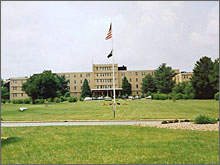
Photo: Ancora Hospital
|
| The headquarters complex sits at the center of the Ancora Hospital grounds. Larger |
a 9-inch hunting knife to stab his mother and father to death in 1996, walked off the grounds. He remained missing for several hours until police found him, stark naked, along the railroad tracks in a nearby town. He was returned to Ancora where, sometime later, he hanged himself with a bed sheet in a hospital bathroom while supposedly under direct staff supervision. Today, stories like those of Enman and Crandell -- disturbing though they are -- are rare at Ancora. Despite the screaming headlines and sensational press, Ancora Psychiatric Hospital has steadily built a reputation for excellence in its clinical services and innovative programs. Its Suicide Prevention Program was the first run by a state hospital and staffed by psychiatrists, while its Self-Help Center was the first of its kind on the grounds of a state psychiatric hospital -- if not the nation. Its new "treatment malls"
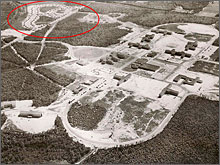
Photo: Ancora Hospital
|
| The tract of Ancora staff housing that gave rise to the urban legend of a 'mystery village' can be seen in the upper left corner of this 1950's aerial photo. The entire tract was demolished. The main hospital complex can be seen in the foreground. Larger |
are dedicated areas where patients select and schedule classes designed to help prepare them for discharge and cultivate leisure activities. The hospital even offers patients under 22 the opportunity to earn their GEDs. And, just like nearby high schools, it conducts graduation ceremonies every June. Abandoned village
So what's the real story behind those online tales of an Ancora village hidden away in the woods and rife with a history of murder, mayhem and ghostly goings-on?
Turns out there actually was a village of sorts located just across Spring Garden Road from the main entrance to the hospital grounds. Built in 1955, it was a housing development of 100 prefab homes manufactured by Trilco Terminal in Toms River to provide housing for Ancora staff members and their families. It had the cookie-cutter look and feel

Photo: Ancora Hospital
|
| This is one of the 100 prefab homes in the tract as it looked in the 1980s. Larger |
of other typical, post-WWII "Levittown" -like housing tracts and a living environment pretty much like any other South Jersey community. Described by Social Worker and former resident David Helfand as "by no means luxurious," the homes were built on concrete slabs with very little insulation. The "big" model had three bedrooms, living room, bath, attic, utility room, and an outside shed; smaller models had two bedrooms.
But ask Ancora employees former and present what it was like to live there as children and they paint a picture of an ethnically-diverse, tight-knit community they remember as "an amazing place." Some -- like Helfand -- still refer to themselves as "Ancora Kids" when telling their stories.
There was a cottage where you could shop weekly and place orders

Photo: Ancora Hospital
|
| The tract homes were abandoned for a short period during which they were vandalized and overgrown. Larger |
for fresh meat and produce. Bus stops along Spring Garden Road took the kids to school. Summers meant swimming in the hospital's pool and fishing in the nearby lake. There were greenhouses, an outdoor track, and paths for leisurely walks. There was also a chapel and a cafeteria for high-functioning patients and staff. A Woman's Club held an annual banquet, and organized athletic teams -- softball, basketball and volleyball -- put the playing fields and hospital gym to good use. Senior Clerk Transcriber Beth Kaminsky, another "Ancora Kid," remembers the homes being very well maintained, with residents taking special pride in colorful gardens and flower beds that somehow thrived in the sandy soil of the pines.
But in the 1980s, faced with a budget crisis, the state stopped subsidizing
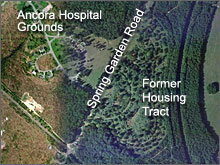
Photo: Google Earth
|
| In current satellite photos, the outlines of the housing tract's street grid can still be seen. Larger |
employees' rent. Given the small size of the houses and rising costs, people began moving out. By 1988 only 25% of the employee homes were occupied. So the state started using the vacant ones for a variety of social programs -- some worked, some didn't. For a brief period, Welfare families facing homelessness were moved into 20 of the houses after exhausting their emergency shelter benefits in regional motels.
Considered by some state officials a "last resort" until the county could find more suitable solutions, strict rules were established -- curfews required children under 10 to be indoors by dark; there were no telephones, washers or dryers in the houses. Hospital vans took the children to school and their parents shopping, to local laundromats, medical appointments, and on interviews for permanent housing.
At the same time, the hospital designated two homes for a new Brief-Visit Program to allow families to test living with soon-to-be-released relatives in a safe, home-like setting -- a program that proved successful and continues to this day at another location on hospital grounds.
But hospital employees remember problems arising in the final days of

Photo: Hoag Levins
|
| Today, there is nothing left of the tract housing development; even the streets have been removed, leaving only muddy ruts and wild growth where a thriving community of Ancora staffers once stood. Larger |
the "last-resort" community when drug dealing started and hospital security found itself policing a rough neighborhood at night. It wasn't long afterward that the entire community was shut down and the houses bulldozed. Their concrete slabs, sidewalks, streetlights, and even the streets themselves, were demolished and trucked away. Today all that remains are breaks in the tree line along Spring Garden Road and muddy ruts arcing through acres of wild Pinelands growth. One employee described it best: "When I drove back there last week to see my house I couldn't even find it. The entire area is growing back into a forest -- like it never even existed."
Ancora CemeteryPerhaps the most secluded and least known of Ancora's historical sites is the
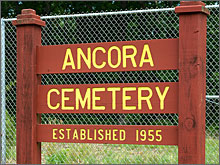
Photo: Hoag Levins
|
| Since Ancora opened in 1955, more than 600 patients died and were buried in a secluded cemetery there. Larger |
hospital's own cemetery, surrounded by dense woods in the middle of its sprawling grounds. Established in 1955 when the hospital opened, it is the final resting place of 600 patients buried there either by choice or due to financial necessity.
A tidy white fence surrounds the cemetery; a gate is flanked by four cement columns, each topped with the statue of an angel. The fence, new gate and statuary was the project of current CEO of Support Services John Lubitsky who, when he first toured the cemetery, found it sadly neglected and in disrepair.
Hospital employees who routinely stop by the cemetery -- like Lorie Triantos, executive assistant to the CEO -- say rarely, if ever, do family or friends visit. There's never anything left on the graves, nor any evidence that relatives had been there to remember their loved ones.
But in researching this article, I found a blog post from someone in Washington who remembered an aunt buried there:
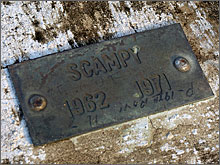
Photo: Hoag Levins
|
| One of the graves contain the remains of "Scampy," a cat owned by the wife of a former Ancora CEO. Larger |
"She was my grandmother's sister. She lived in NY before ending up in Ancora. This is just to humanize her. Thank you." Today, visitors are encouraged to call the hospital (609-561-1700, ext. 7444) for help in finding the graves of family members, as well as the secluded little cemetery itself. One grave in particular caught my eye when I visited on a crisp September afternoon. According to the grave permit, burial site #174 was prepared for "a patient who lived a long life." The marker bears one name -- "Scampy" -- and the dates 1962 - 1971. Rumor has it that a former hospital CEO and medical director had his wife's beloved cat buried there.
A poignant little story for cat lovers, to be sure. But given the web's penchant for turning benign bits of Ancora history into hyped-up horror stories, don't be surprised if Google searches one day turn up tales of a ghostly cat heard wailing desolately from the lunatic asylum's secret graveyard in the pines.
Sandy Levins is the President of the Camden County Historical Society and proprietor of HistoricFauxFoods.com, a company that makes historically accurate fake foods for historic homes and museums. | 
